 Facebook
Facebook
 X
X
 Instagram
Instagram
 TikTok
TikTok
 Youtube
Youtube
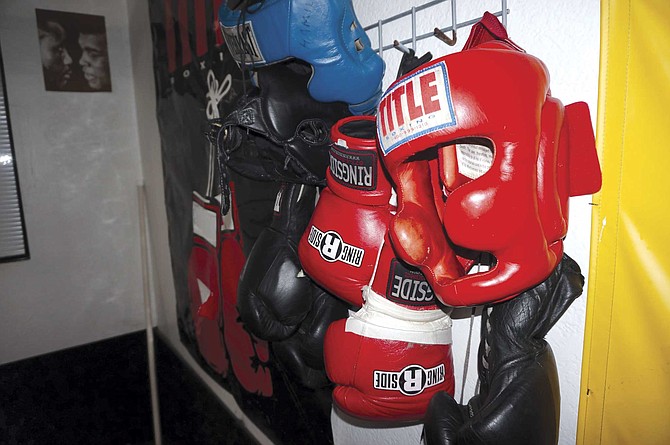
His was once the most celebrated name in boxing—“The Old Mongoose,” “Ageless Archie,” or simply Archie Moore, the longest-reigning light heavyweight champ.
Archie was born in Benoit Mississippi, as his mother claimed, or Collinsville, Illinois, as he said, in 1913 or 1916 (Moore was as much a master of the press as he was of his right hook). He moved to San Diego in 1938, and died here of heart failure 60 years later. By then, he had worked his way into the hearts of the public and become one of our city’s most prominent citizens. He was the greatest puncher ever to hit this town, and his 141 official knockouts remain a world record in no danger of ever being broken.
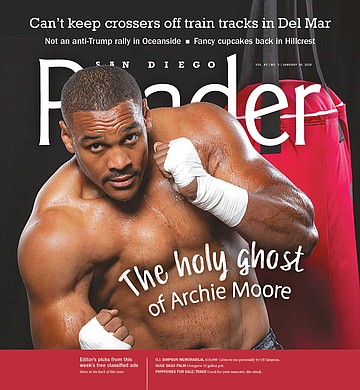
Perhaps ironically, Moore used boxing as a way of keeping kids from violent crime, and instructing them in the power of self-defense, education, respect, patriotism, and faith.
Beginning with President Eisenhower in the 1950s, Moore met with three sitting U.S. presidents to explain his vision that the nation was headed for what many considered absurd in clean-cut post-war America: a gang and a drug epidemic. He was so convinced of the plague’s arrival, and that the twin-headed dragon could be defeated through prevention, that he founded and funded an organization he named Any Boy Can, which would eventually be renamed Anybody Can (to accommodate girls) and is now known as the ABC Youth Foundation.
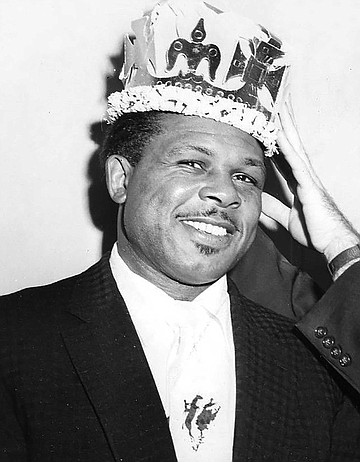
Today, Archie’s dream lives on through his son Billy, in a small tract home converted to a boxing gym and tutoring center at 3130 Market Street in the San Diego neighborhood of Stockton. There, boys and girls learn self-defense and other valuable life skills.
Within the 1200 square feet of ABC are a library, half a dozen heavy bags, nearly as many speed bags, and a boxing ring. Five mornings a week find Billy Moore — a passionate and compassionate man, a once-promising heavyweight who went the distance with former champion Tony Tubbs — battling to save the kids he loves. Moore commands the respect of the city, but nowhere more than in the ring, where he teaches the ABC concept, a manifesto first employed by his father in the mid-1950s. The foundation’s mission statement sums up the vision: “Empowering youth to step off in life with their best foot forward, without cowardice, but with courage and dignity.”
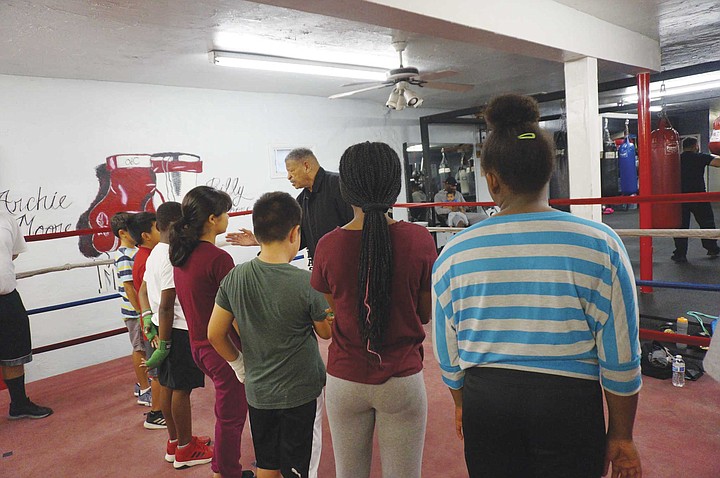
ABC has proven successful in keeping its students off the streets while leading others to further success, as evidenced by their alumni graduating from such prestigious colleges as Morehouse and Yale. Many ABC kids, who range in age from 7 to 70, are what could be called “at-risk” or “latchkey,” kids who have been spoon-fed on hard times. Suspicion of authority is rampant. Yet they snap to attention at Coach Moore’s booming command, before he questions them concerning their dreams. One at a time, they reveal their goals and how they intend to put them into reality. The group then recites an old-fashioned hand-on-heart pledge of allegiance.
The pledge completed, some turn to pound heavy bags while others rhythmically tap speed bags, keeping time as if using a metronome. Some eventually enter the ring to punch at the practice pads held by Coach Moore or one of his assistants: Coach Bob, Big D, Apple Bomb, or Bobo. Occasionally, fighters wearing protective gear battle it out for a few rounds. When they do, everyone watches.
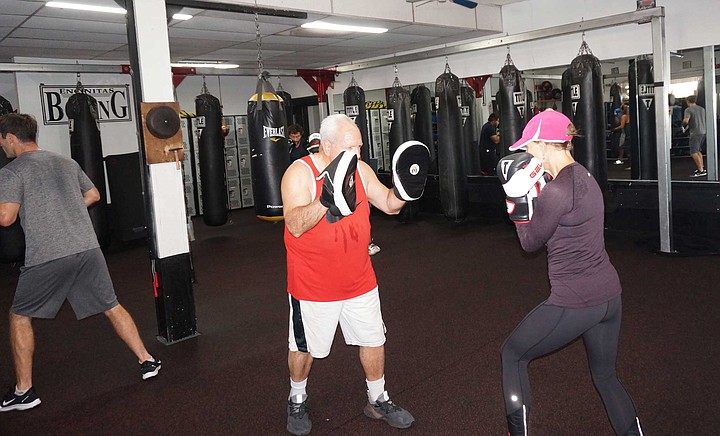
A friendly, maybe holy (ABC is, after all, a faith-based organization) ghost seems to lurk within the building, channeling Archie’s wisdom to children as they release emotions against leather, making that unmistakably satisfying sound. The air is thick with the smells of hard work, defeat, and victory.
Encinitas Boxing & Fitness
Dana Donahue, along with her ex-husband Tom Donahue, is the co-owner of Encinitas Boxing & Fitness. They bought the place over two decades ago when it was a racquetball facility and converted it to North County San Diego’s first boxing gym. Having worked there as an instructor since the beginning, Dana has witnessed a sharp uptick in the numbers of those wanting to learn boxing. She has also observed a gender shift. “Currently, our classes are about 50 percent women.”
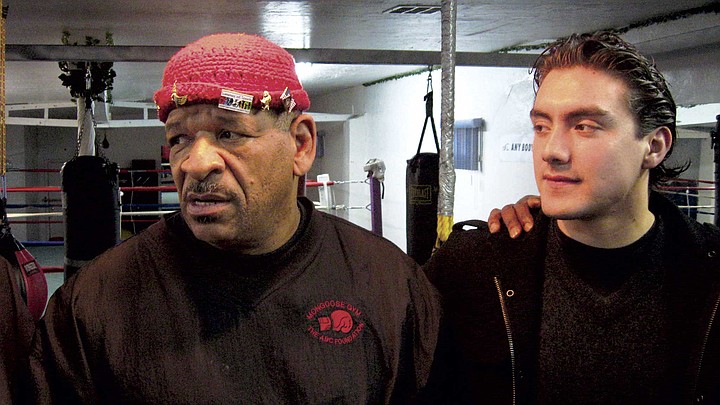
There are daily classes for adults of all ages and for kids between 10 and 17. They all share at least one common denominator, according to Dana, “Boxing tends to attract people who don’t like participating in group sports.”
It is well known that the most famous name in boxing, Muhammad Ali, suffered from Parkinson’s Disease, probably the result of multiple hammer fists to the head. Ali would, no doubt, approve of the Encinitas Club’s “Rock Steady Boxing,” which employs the sport as a way for people with Parkinson’s to hold their symptoms at bay. According to Dana, “You can see the difference in patients after only a few lessons. One man who used to come in with a walker now walks in without one.”
Personal trainer and boxing enthusiast Cameron Trickey had this to say concerning the scientific connection between pugilism and brain function. “Boxing uses both sides of the body and sends messages to the brain that aid cognitive abilities and motor control. It is especially beneficial for patients who have Parkinson’s Disease.”
Extreme Power
Ruben Rowell Jr. owns and operates Extreme Power Gym, a mid-sized boxing facility, and Muay Thai dojo in Oceanside. Rowell is equal parts philosopher and warrior, and a firm believer in leveraging pain as a teacher. If you plan to sign up for lessons, be prepared to work. As he’s being interviewed for this article, a group of pre-teen boys and girls show up for class. Without rising from his chair, he points to a practice mat and instructs them to do 400 burpees. A burpee, for those who don’t know, requires dropping to push-up position, springing to the feet, and jumping.
In a scenario reminiscent of The Karate Kid, Rowell first learned martial arts in response to the bullies that regularly pounded him. Once he repaid his assailants with a well-deserved beat-down, he followed a more peaceful path, punctuated by some hard-fought battles in the ring, where he became a Muay Thai champion. He learned to stay clear of violence and ignore insults before 1986, the year he entered the Marine Corps (where his dark skin put him at odds with some individuals in his unit who were Ku Klux Klan members.)
After surviving basic training, Rowell was stationed at Camp Pendleton in Oceanside. From there, it was an hour-plus drive each day to Spud Murphy’s Gym in downtown San Diego, where he has fond memories of getting black eyes and busted lips, and of pissing blood for two weeks after trading punches in the ring. According to Ruben, “Murphy’s was like something out of Rocky II — there was no sign on the door, and you had to walk down several flights of stairs to get there. I’d be driving there, scared shitless the entire time, because somebody was getting knocked out cold or dropped to the canvas there every night. At times, I’d get hit so hard that everything went blurry. That’s when you learn to put on your best poker face, letting your opponent think he has given you his best shot and not hurt you.
“I don’t teach kids to beat anybody up — I teach them discipline, which means doing what needs doing when you don’t feel like it. Ask your mom and dad if they want to get up and go to work each day. The answer is probably no, but they do it anyway. That’s discipline.”
Like many masters of martial arts, Rowell does not need to prove himself through fighting. While that has its benefits in his personal life, it may have worked to his competitive disadvantage. “In my prime, I had to get hit five or six times before I’d hit back,” he said.
“My dad was old school, and the nicest guy I ever knew, but you didn’t want to cross him. He’d say, ‘If someone comes after me, I won’t fight them; I’ll shoot their ass.’ His attitude toward fighting was to avoid it. If you couldn’t, it should be so serious that someone will end up in Intensive Care or the graveyard. I will never raise my fist to anyone first. When I teach hand-to-hand combat at Camp Pendleton Marine base, however, I’m not teaching fighting; I’m teaching survival and killing.
“I haven’t been in a street fight since I was a kid, but I never turn my sense of awareness off. When I’m out somewhere, I size up who’s the toughest guy in the place, and who’s a loud-mouthed bitch. If I feel the flow of the room going toward a fight, I slip out the back door. ‘Big Dad,’ my grandfather on my Dad’s side, used to say, ‘Junebug’ — that was his name for me — ‘most of the time, it’s better to hear about a fight than to see one, because you could end up in jail, or worse.’”
Heavyweight contender
In one sense, boxing is not complicated. Two people try to hit each other as often and as hard as they can. The one that hits hard enough to knock the other one out, or who scores the most significant hits, usually wins. Still, some of the details of prizefighting can be confusing to fans. For one thing, there is not one significant championship belt, but four of them: The International Boxing Federation (IBF), the World Boxing Federation (WBF), the World Boxing Organization (WBO), and the World Boxing Council (WBC.) Multiply that by 34 divisions (17 for men and 17 for women) ranging from mini flyweight (105 pounds and under) to heavyweight (200 pounds and up). It’s the power blows of the heavyweights that fill the most seats.
Heavyweight boxing depends as much on personality as it does on knockout power. There is no shortage of either in this division these days. Andy Ruiz, “The Mexican Rocky;” Deontay Wilder, “The Bronze Bomber;” and Tyson Fury “The Gypsy King” have colorful fight names, their own entrance music, and entertaining backstories. In Wilder’s case, there is also a jewel-studded robe and mask he wears as he swaggers toward the ring. Perhaps that, and certainly his championship belt, have helped deflect much of the spotlight away from the cage of mixed martial arts and back into the ring.
Former Heavyweight Champion of the World George Foreman made a point about compassion when he referenced his famous Rumble in the Jungle with Muhammad Ali, saying, “The best punch of the fight was the one that was never thrown.” In the eighth round, Foreman was on his way to the canvas after a combination from Ali dropped him. Ali locked and loaded for a final insurance punch, but pulled back for no explainable reason other than concern for his opponent’s well-being.
Australia-to-San Diego transplant Trent Rawlins may not be as generous as Ali in the restraint department, but he does say, “I have nothing against anyone I’m fighting. I don’t want to hurt them; I simply want to win.”
Rawlins, twice a champion of Australia, is a gentle, soft-spoken mountain of a man who walks around at 255 lethal pounds, much of it residing in anvil arms connected to wrecking ball fists. At 33 years old, he is getting up there for a fighter, but he has every confidence that he will one day become champion of the world. That confidence was boosted when the last man who stood in the way of his right was knocked out in round one; something Rawlins paid for with a broken hand. When asked if he would have continued fighting if that punch hadn’t knocked out his opponent, he quickly replies, “If I hadn’t knocked him out with my right, I would have knocked him out with my left.”
Rawlins’ professional record is ten wins, two losses, and one draw. “I’ve learned a lot since losing those first fights, and now I’m on a roll.”
“A lot of fighters in other divisions have to cut weight and can get a little agitated at their weigh-ins, because they haven’t been eating. That’s not a problem in my division, because it starts at 200 pounds and there is no upper limit. The biggest fighter I ever faced was 372 pounds, but it was an easy fight. He was too big and too slow. I’m 255 right now, but I like to fight between 235 and 240. The reason I’m heavier now is that I’m still recovering from my broken hand. But I’ve remained in pretty good shape, with around 13 percent body fat.”
The fight game is littered with trash talk that Rawlins shakes off like a poorly aimed jab. “I let ’em say whatever they want, and reply, ‘God bless you, but I’m going to make you pay in the ring.’”
Comparable to football’s Monday morning quarterbacks are what Rawlins calls “boxing cheerleaders.” According to him, “They sit on the sidelines, yelling, ‘This guy should throw more jabs,’ or ‘He’s not doing enough.’ But they have no idea how hard it is to get in the ring for even one minute. Anyone can hit a bag that’s not hitting back. Unless you’ve been in the ring, you shouldn’t talk, cuz you don’t know how it feels to get hit. When you take a hard shot, you have to act like it doesn’t bother you, all the time hoping you’re fooling your opponent and he won’t hit you in that same spot again. Being knocked out is different; when that happens, you don’t feel anything. I’ve been knocked out twice. After I came to, I tried to talk the ref out of stopping the fight, but it was over.
“Boxing is called ‘the sweet science,’ and it is very scientific — kind of like a dangerous game of chess. I’ll study my opponent beforehand, and I’ll know if he’s a counter-puncher, or if he likes to attack. During a fight, I notice little things like him throwing a jab and not bringing his hand back to his face. When he does that, eventually, I’m gonna catch his jab, and come over the top, boom, with the right hand. I’m a puncher, but I can brawl, I can box, I can move.”
When asked how Muhammad Ali might fare against someone like WBC Heavyweight Champion Deontay Wilder, Rawlins replies, “That’s a tough one, but if Wilder landed his right hand on Ali — he, or anyone else, is going down and not getting up. I was at the fight when Wilder fought Tyson Fury, and I still don’t know how Fury (the English heavyweight that battled Wilder to a draw that evening) got up after being hit like that. His eyes rolled back in his head, and he was out. It’s like Wilder has a loaded gun in his hand.”
Some heavyweight boxers, including Tyson Fury and former heavyweight champion Andy Ruiz, don’t look particularly well conditioned. According to Rawlins, however, “They may not look it, but you have to be extremely fit to box 12 rounds. It’s not a bodybuilding competition.” Rawlins trains twice a day, once for two hours in the morning with Tiger Smalls. When that workout is complete, he jams to work with his wife Ashley at their law firm, Rawlins Law, where his wife is the attorney and he is the case manager. By five that evening, he is well into his conditioning workout, which consists of running on the beach or swimming.
When asked what a fighter needs to succeed, Rawlins immediately replied, “You gotta be smart, or have someone behind you who is smart. There are a lot of good fighters who have bad managers and pick the wrong fights at the wrong times — they don’t listen to their bodies — they spar too much and end up being punch drunk. I don’t care how talented you are or how hard you punch — you’ve got to be smart.”
Rawlins was a gifted rugby player in Australia and went straight from his high school team into the pros. When pro rugby didn’t work out, he returned home, disappointed. Concerning that time, he says, “I’m not angry now, but I was then because all my dreams had been taken away. That’s when a friend suggested I try boxing. I was 19 when I went to that gym, and a trainer said, ‘You’ve got a little bit of talent — why not have a fight?’ I did, and I ended up having a good amateur career.”
According to Rawlins, “The most recognized sporting figure when I was growing up was the Heavyweight Champion of the World. In America these days, any of the top heavyweights can walk down any street without anyone recognizing them. In Europe, however, fighters like Ruiz or Wilder would be mobbed if they tried walking down the street.”
Boxing may be the sweet science, but they’re not trading sugar smacks in the ring, and it’s not an entirely safe endeavor. According to Rawlins, “I realize it’s dangerous, and while my wife and my mom support me in fighting, I think they look forward to me retiring. If I had kids, I don’t think I’d want them boxing.
“One thing I love about boxing, though, is its unpredictability. Anything can happen in the ring. No matter how far down you might be in a fight, you’re just one punch away from victory.”


His was once the most celebrated name in boxing—“The Old Mongoose,” “Ageless Archie,” or simply Archie Moore, the longest-reigning light heavyweight champ.
Archie was born in Benoit Mississippi, as his mother claimed, or Collinsville, Illinois, as he said, in 1913 or 1916 (Moore was as much a master of the press as he was of his right hook). He moved to San Diego in 1938, and died here of heart failure 60 years later. By then, he had worked his way into the hearts of the public and become one of our city’s most prominent citizens. He was the greatest puncher ever to hit this town, and his 141 official knockouts remain a world record in no danger of ever being broken.

Perhaps ironically, Moore used boxing as a way of keeping kids from violent crime, and instructing them in the power of self-defense, education, respect, patriotism, and faith.
Beginning with President Eisenhower in the 1950s, Moore met with three sitting U.S. presidents to explain his vision that the nation was headed for what many considered absurd in clean-cut post-war America: a gang and a drug epidemic. He was so convinced of the plague’s arrival, and that the twin-headed dragon could be defeated through prevention, that he founded and funded an organization he named Any Boy Can, which would eventually be renamed Anybody Can (to accommodate girls) and is now known as the ABC Youth Foundation.

Today, Archie’s dream lives on through his son Billy, in a small tract home converted to a boxing gym and tutoring center at 3130 Market Street in the San Diego neighborhood of Stockton. There, boys and girls learn self-defense and other valuable life skills.
Within the 1200 square feet of ABC are a library, half a dozen heavy bags, nearly as many speed bags, and a boxing ring. Five mornings a week find Billy Moore — a passionate and compassionate man, a once-promising heavyweight who went the distance with former champion Tony Tubbs — battling to save the kids he loves. Moore commands the respect of the city, but nowhere more than in the ring, where he teaches the ABC concept, a manifesto first employed by his father in the mid-1950s. The foundation’s mission statement sums up the vision: “Empowering youth to step off in life with their best foot forward, without cowardice, but with courage and dignity.”

ABC has proven successful in keeping its students off the streets while leading others to further success, as evidenced by their alumni graduating from such prestigious colleges as Morehouse and Yale. Many ABC kids, who range in age from 7 to 70, are what could be called “at-risk” or “latchkey,” kids who have been spoon-fed on hard times. Suspicion of authority is rampant. Yet they snap to attention at Coach Moore’s booming command, before he questions them concerning their dreams. One at a time, they reveal their goals and how they intend to put them into reality. The group then recites an old-fashioned hand-on-heart pledge of allegiance.
The pledge completed, some turn to pound heavy bags while others rhythmically tap speed bags, keeping time as if using a metronome. Some eventually enter the ring to punch at the practice pads held by Coach Moore or one of his assistants: Coach Bob, Big D, Apple Bomb, or Bobo. Occasionally, fighters wearing protective gear battle it out for a few rounds. When they do, everyone watches.

A friendly, maybe holy (ABC is, after all, a faith-based organization) ghost seems to lurk within the building, channeling Archie’s wisdom to children as they release emotions against leather, making that unmistakably satisfying sound. The air is thick with the smells of hard work, defeat, and victory.
Encinitas Boxing & Fitness
Dana Donahue, along with her ex-husband Tom Donahue, is the co-owner of Encinitas Boxing & Fitness. They bought the place over two decades ago when it was a racquetball facility and converted it to North County San Diego’s first boxing gym. Having worked there as an instructor since the beginning, Dana has witnessed a sharp uptick in the numbers of those wanting to learn boxing. She has also observed a gender shift. “Currently, our classes are about 50 percent women.”

There are daily classes for adults of all ages and for kids between 10 and 17. They all share at least one common denominator, according to Dana, “Boxing tends to attract people who don’t like participating in group sports.”
It is well known that the most famous name in boxing, Muhammad Ali, suffered from Parkinson’s Disease, probably the result of multiple hammer fists to the head. Ali would, no doubt, approve of the Encinitas Club’s “Rock Steady Boxing,” which employs the sport as a way for people with Parkinson’s to hold their symptoms at bay. According to Dana, “You can see the difference in patients after only a few lessons. One man who used to come in with a walker now walks in without one.”
Personal trainer and boxing enthusiast Cameron Trickey had this to say concerning the scientific connection between pugilism and brain function. “Boxing uses both sides of the body and sends messages to the brain that aid cognitive abilities and motor control. It is especially beneficial for patients who have Parkinson’s Disease.”
Extreme Power
Ruben Rowell Jr. owns and operates Extreme Power Gym, a mid-sized boxing facility, and Muay Thai dojo in Oceanside. Rowell is equal parts philosopher and warrior, and a firm believer in leveraging pain as a teacher. If you plan to sign up for lessons, be prepared to work. As he’s being interviewed for this article, a group of pre-teen boys and girls show up for class. Without rising from his chair, he points to a practice mat and instructs them to do 400 burpees. A burpee, for those who don’t know, requires dropping to push-up position, springing to the feet, and jumping.
In a scenario reminiscent of The Karate Kid, Rowell first learned martial arts in response to the bullies that regularly pounded him. Once he repaid his assailants with a well-deserved beat-down, he followed a more peaceful path, punctuated by some hard-fought battles in the ring, where he became a Muay Thai champion. He learned to stay clear of violence and ignore insults before 1986, the year he entered the Marine Corps (where his dark skin put him at odds with some individuals in his unit who were Ku Klux Klan members.)
After surviving basic training, Rowell was stationed at Camp Pendleton in Oceanside. From there, it was an hour-plus drive each day to Spud Murphy’s Gym in downtown San Diego, where he has fond memories of getting black eyes and busted lips, and of pissing blood for two weeks after trading punches in the ring. According to Ruben, “Murphy’s was like something out of Rocky II — there was no sign on the door, and you had to walk down several flights of stairs to get there. I’d be driving there, scared shitless the entire time, because somebody was getting knocked out cold or dropped to the canvas there every night. At times, I’d get hit so hard that everything went blurry. That’s when you learn to put on your best poker face, letting your opponent think he has given you his best shot and not hurt you.
“I don’t teach kids to beat anybody up — I teach them discipline, which means doing what needs doing when you don’t feel like it. Ask your mom and dad if they want to get up and go to work each day. The answer is probably no, but they do it anyway. That’s discipline.”
Like many masters of martial arts, Rowell does not need to prove himself through fighting. While that has its benefits in his personal life, it may have worked to his competitive disadvantage. “In my prime, I had to get hit five or six times before I’d hit back,” he said.
“My dad was old school, and the nicest guy I ever knew, but you didn’t want to cross him. He’d say, ‘If someone comes after me, I won’t fight them; I’ll shoot their ass.’ His attitude toward fighting was to avoid it. If you couldn’t, it should be so serious that someone will end up in Intensive Care or the graveyard. I will never raise my fist to anyone first. When I teach hand-to-hand combat at Camp Pendleton Marine base, however, I’m not teaching fighting; I’m teaching survival and killing.
“I haven’t been in a street fight since I was a kid, but I never turn my sense of awareness off. When I’m out somewhere, I size up who’s the toughest guy in the place, and who’s a loud-mouthed bitch. If I feel the flow of the room going toward a fight, I slip out the back door. ‘Big Dad,’ my grandfather on my Dad’s side, used to say, ‘Junebug’ — that was his name for me — ‘most of the time, it’s better to hear about a fight than to see one, because you could end up in jail, or worse.’”
Heavyweight contender
In one sense, boxing is not complicated. Two people try to hit each other as often and as hard as they can. The one that hits hard enough to knock the other one out, or who scores the most significant hits, usually wins. Still, some of the details of prizefighting can be confusing to fans. For one thing, there is not one significant championship belt, but four of them: The International Boxing Federation (IBF), the World Boxing Federation (WBF), the World Boxing Organization (WBO), and the World Boxing Council (WBC.) Multiply that by 34 divisions (17 for men and 17 for women) ranging from mini flyweight (105 pounds and under) to heavyweight (200 pounds and up). It’s the power blows of the heavyweights that fill the most seats.
Heavyweight boxing depends as much on personality as it does on knockout power. There is no shortage of either in this division these days. Andy Ruiz, “The Mexican Rocky;” Deontay Wilder, “The Bronze Bomber;” and Tyson Fury “The Gypsy King” have colorful fight names, their own entrance music, and entertaining backstories. In Wilder’s case, there is also a jewel-studded robe and mask he wears as he swaggers toward the ring. Perhaps that, and certainly his championship belt, have helped deflect much of the spotlight away from the cage of mixed martial arts and back into the ring.
Former Heavyweight Champion of the World George Foreman made a point about compassion when he referenced his famous Rumble in the Jungle with Muhammad Ali, saying, “The best punch of the fight was the one that was never thrown.” In the eighth round, Foreman was on his way to the canvas after a combination from Ali dropped him. Ali locked and loaded for a final insurance punch, but pulled back for no explainable reason other than concern for his opponent’s well-being.
Australia-to-San Diego transplant Trent Rawlins may not be as generous as Ali in the restraint department, but he does say, “I have nothing against anyone I’m fighting. I don’t want to hurt them; I simply want to win.”
Rawlins, twice a champion of Australia, is a gentle, soft-spoken mountain of a man who walks around at 255 lethal pounds, much of it residing in anvil arms connected to wrecking ball fists. At 33 years old, he is getting up there for a fighter, but he has every confidence that he will one day become champion of the world. That confidence was boosted when the last man who stood in the way of his right was knocked out in round one; something Rawlins paid for with a broken hand. When asked if he would have continued fighting if that punch hadn’t knocked out his opponent, he quickly replies, “If I hadn’t knocked him out with my right, I would have knocked him out with my left.”
Rawlins’ professional record is ten wins, two losses, and one draw. “I’ve learned a lot since losing those first fights, and now I’m on a roll.”
“A lot of fighters in other divisions have to cut weight and can get a little agitated at their weigh-ins, because they haven’t been eating. That’s not a problem in my division, because it starts at 200 pounds and there is no upper limit. The biggest fighter I ever faced was 372 pounds, but it was an easy fight. He was too big and too slow. I’m 255 right now, but I like to fight between 235 and 240. The reason I’m heavier now is that I’m still recovering from my broken hand. But I’ve remained in pretty good shape, with around 13 percent body fat.”
The fight game is littered with trash talk that Rawlins shakes off like a poorly aimed jab. “I let ’em say whatever they want, and reply, ‘God bless you, but I’m going to make you pay in the ring.’”
Comparable to football’s Monday morning quarterbacks are what Rawlins calls “boxing cheerleaders.” According to him, “They sit on the sidelines, yelling, ‘This guy should throw more jabs,’ or ‘He’s not doing enough.’ But they have no idea how hard it is to get in the ring for even one minute. Anyone can hit a bag that’s not hitting back. Unless you’ve been in the ring, you shouldn’t talk, cuz you don’t know how it feels to get hit. When you take a hard shot, you have to act like it doesn’t bother you, all the time hoping you’re fooling your opponent and he won’t hit you in that same spot again. Being knocked out is different; when that happens, you don’t feel anything. I’ve been knocked out twice. After I came to, I tried to talk the ref out of stopping the fight, but it was over.
“Boxing is called ‘the sweet science,’ and it is very scientific — kind of like a dangerous game of chess. I’ll study my opponent beforehand, and I’ll know if he’s a counter-puncher, or if he likes to attack. During a fight, I notice little things like him throwing a jab and not bringing his hand back to his face. When he does that, eventually, I’m gonna catch his jab, and come over the top, boom, with the right hand. I’m a puncher, but I can brawl, I can box, I can move.”
When asked how Muhammad Ali might fare against someone like WBC Heavyweight Champion Deontay Wilder, Rawlins replies, “That’s a tough one, but if Wilder landed his right hand on Ali — he, or anyone else, is going down and not getting up. I was at the fight when Wilder fought Tyson Fury, and I still don’t know how Fury (the English heavyweight that battled Wilder to a draw that evening) got up after being hit like that. His eyes rolled back in his head, and he was out. It’s like Wilder has a loaded gun in his hand.”
Some heavyweight boxers, including Tyson Fury and former heavyweight champion Andy Ruiz, don’t look particularly well conditioned. According to Rawlins, however, “They may not look it, but you have to be extremely fit to box 12 rounds. It’s not a bodybuilding competition.” Rawlins trains twice a day, once for two hours in the morning with Tiger Smalls. When that workout is complete, he jams to work with his wife Ashley at their law firm, Rawlins Law, where his wife is the attorney and he is the case manager. By five that evening, he is well into his conditioning workout, which consists of running on the beach or swimming.
When asked what a fighter needs to succeed, Rawlins immediately replied, “You gotta be smart, or have someone behind you who is smart. There are a lot of good fighters who have bad managers and pick the wrong fights at the wrong times — they don’t listen to their bodies — they spar too much and end up being punch drunk. I don’t care how talented you are or how hard you punch — you’ve got to be smart.”
Rawlins was a gifted rugby player in Australia and went straight from his high school team into the pros. When pro rugby didn’t work out, he returned home, disappointed. Concerning that time, he says, “I’m not angry now, but I was then because all my dreams had been taken away. That’s when a friend suggested I try boxing. I was 19 when I went to that gym, and a trainer said, ‘You’ve got a little bit of talent — why not have a fight?’ I did, and I ended up having a good amateur career.”
According to Rawlins, “The most recognized sporting figure when I was growing up was the Heavyweight Champion of the World. In America these days, any of the top heavyweights can walk down any street without anyone recognizing them. In Europe, however, fighters like Ruiz or Wilder would be mobbed if they tried walking down the street.”
Boxing may be the sweet science, but they’re not trading sugar smacks in the ring, and it’s not an entirely safe endeavor. According to Rawlins, “I realize it’s dangerous, and while my wife and my mom support me in fighting, I think they look forward to me retiring. If I had kids, I don’t think I’d want them boxing.
“One thing I love about boxing, though, is its unpredictability. Anything can happen in the ring. No matter how far down you might be in a fight, you’re just one punch away from victory.”
Comments